Apple's iPhone 4: Thoroughly Reviewed
by Brian Klug & Anand Lal Shimpi on June 30, 2010 4:06 AM EST- Posted in
- Smartphones
- Apple
- iPhone 4
- Gadgets
- Mobile
Camera Usability
It still takes almost two seconds to activate the camera on the 4, which is enough time to miss whatever it is you’re trying to grab a photo of. Thanks to the iOS 4 update however, the shutter is almost instantaneous. The difference appears to be that the photo is committed to memory but not fully written to NAND, whereas before the photo would be written to the Flash before you could take another picture. Power loss in the middle of snapping photos seems pretty rare on a smartphone so the tradeoff, if I’m correct, makes sense.
Apple opted for a lower noise rather than higher resolution sensor in the iPhone 4 and it did pay off. The main camera shoots photos at 2592 x 1936 compared to the EVO 4G’s 3264 x 1952, but the resulting images are far less noisy - particularly in low light situations:
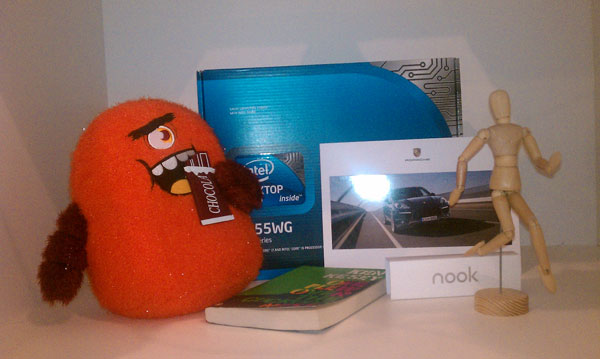
HTC EVO 4G - Low Light
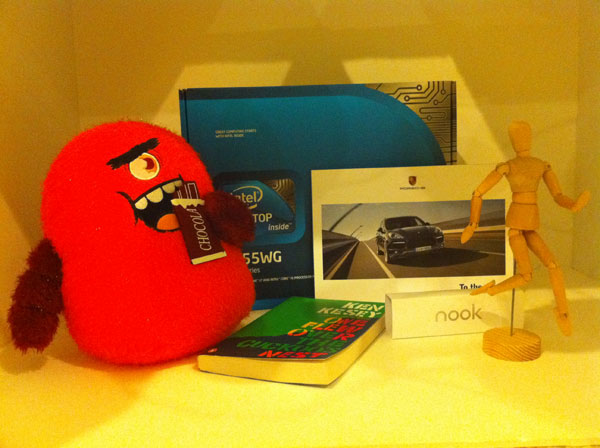
Apple iPhone 4 - Low Light
The 4’s main camera, like the HTC Incredible and EVO 4G, is a decent replacement for a point and shoot if you’re primarily outdoors. You’re still going to get better image quality out of a good point and shoot, but the tradeoff is convenience. The limitations are significant.
Because you rely on the iPhone 4’s software controlled aperture and shutter speed you don’t have the ability to properly expose the image. You have to rely on Apple’s algorithms, which tend to either overexpose outdoors or miscalculate white balance with non-halogen light sources.
This is an example of a photo taken outdoors that’s more washed out than it needs to be:

And many of you picked up on the white balance issue I snuck into our EVO 4G review yesterday:

Regardless of where I tapped to focus, I could not get the iPhone 4 to set a proper white balance in our photo box.
While I was watching the screen, the iPhone 4 would alternate between yellow and white for the background color. It seemed to be trying to calculate the white point but was just being thrown off by the type of light. If I timed the shot right I could snag the photo while the iPhone was switching between white balance points:
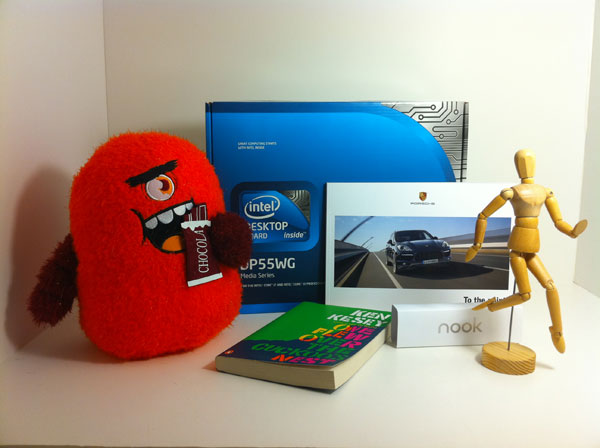
I also had this problem in my office which uses LED can lights.

This is far more yellow than it should be
While Brian didn't have the same problems I did, Brandon Hill (DailyTech Editor in Chief) did. It seems to be very dependent on the type of lighting you have and even then it seems to vary based on the type of CFLs. And unlike the EVO 4G, there’s no way to manually set a white balance on the 4.
For overall image quality though I have to hand it to Apple, the iPhone 4 does do a better job than the EVO 4G or other phones I’ve used. Take a look at this shot inside my house:
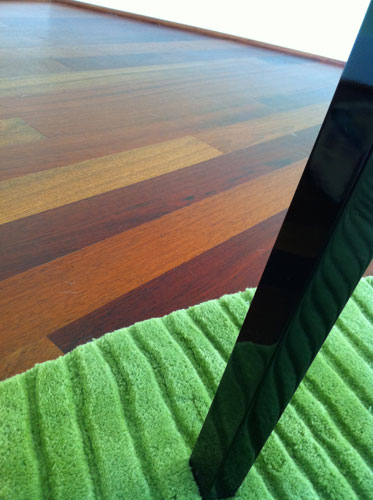
The colors in the iPhone 4 shot are on point. The green is correct, the wooden floor is right and the black is, well, black. The EVO 4G didn’t do so well on this test by comparison:

The 4’s camera isn’t perfect, but it does appear to handle colors better than the EVO (with the exception of my white balance issue) and delivers lower noise photos.
Compared to other phones the 4 does similarly well, besting the 5 megapixel camera in the Motorola Droid easily in terms of color reproduction and sharpness. Though the HTC Incredible previously was a top performer alongside the N900, the iPhone 4 makes the Incredible look a bit oversharpened and artificial. Compared to the 3GS, the iPhone 4's improvement is obviously dramatic, as shown in the gallery below.
Video is recorded at 1280x720, in H.264 with AAC mono audio. We measured a bitrate of 1.35 MBps, outclassing all the other smartphones we've tested.
iPhone 4
HTC Droid Incredible
Motorola Droid
Nokia N900
What's interesting is that the iPhone 4 appears to crop the sensor down for video recording, taking the center most 1280x720 pixels instead of scaling down the entire image size. The result is that the focal length for video recording is notably longer than when taking photos.
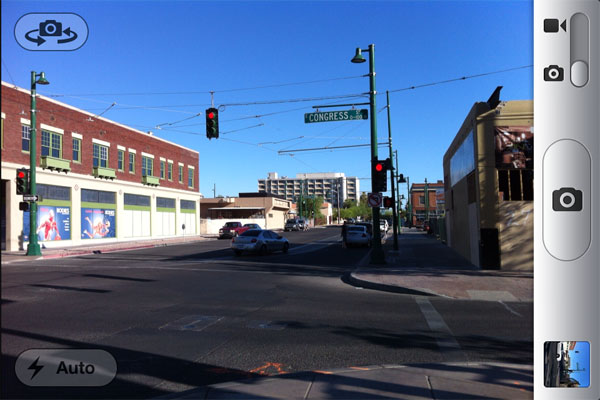

You can see the difference is quite notable standing in the same place. Perhaps the A4 SoC lacks the compute power to apply a scale and encode at the same time, necessitating this crop. Whatever the case, video shot with the iPhone 4 still looks very good at the promised and delivered 30 FPS. Move the camera around enough, and there's still screen door effect from the rolling shutter like any CMOS sensor is going to give you - it's a fundamental problem no phones are going to get around soon. Its also right there in the specifications page for the camera SoC; rolling shutter.
Similarly, iPhone 4 does give you 5x digital zoom, though we still maintain you're better off taking photos at native resolution and messing with them later with better interpolation algorithms.
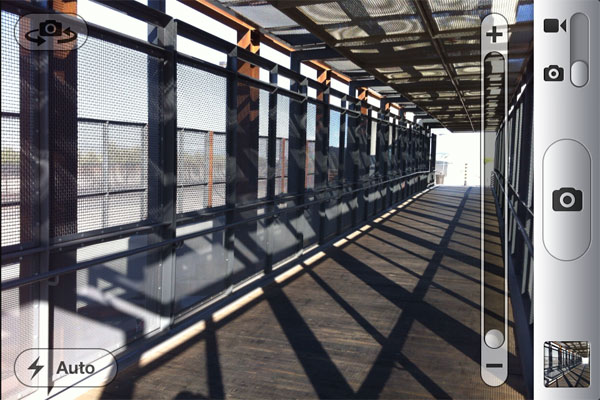
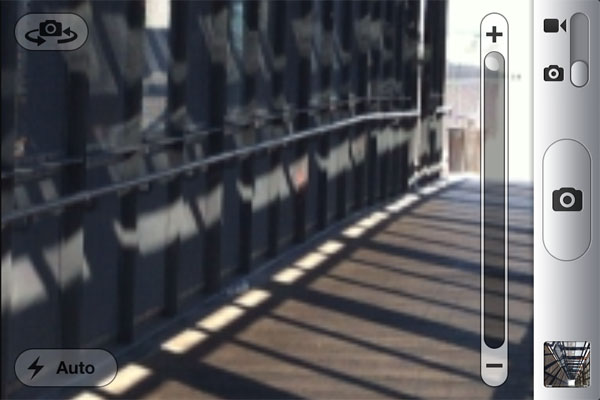






















270 Comments
View All Comments
philosofa - Wednesday, June 30, 2010 - link
This kind of in-depth and insightful review is exactly why I read pretty much every Anandtech article (that and a liberal workplace when it comes to browsing lol). Cheers very much Brian & Anand. Don't feel a huge urge to upgrade from my 3GS, but it does look like a pretty damn fine smartphone!quiksilvr - Wednesday, June 30, 2010 - link
Yeah, but he's holding it wrong :(medi01 - Wednesday, June 30, 2010 - link
But guys, who do you pay a fortune for these phones? If you'd buy iphone or whatever phone with 2 year contract in most of Europe you'd pay just the price of the phone over 2 years (a bit more, in case of iphones it's about 700 Euro)I mean, aren't there cheaper contracts? I could imagine, that you can't buy some models other than from mobile providers, but hey, there are other countries with online shops.
Snotling - Thursday, July 1, 2010 - link
In north America and even more in Canada, there is a lot of territory to cover and lower population density. Cellular networks need to plant antennas where there is theoretically too few users to pay for it.JimmiG - Thursday, July 1, 2010 - link
Sweden is kind of like a smaller version of Canada. Apart from the three major metro regions (Stockholm, Malmo and Gothenburg), the country is very sparsely populated. An average city is maybe 50,000 people. Yet we have extremely affordable plans by comparison.. I mean like less than $10 for a perfectly usable plan (1GB of data or so) and no more than $20 for 5GB or even Unlimited. Paying $100 a moth..geez. I barely pay that in a year.Ratinator - Friday, July 2, 2010 - link
Sorry, I think that is a bad comparison.Sweden is 2/3rd the size of the province of Saskatchewan and 9 times the population of Saskatchewan as well. You can't even compare Sweden to the province of Saskatchewan let alone Canada. You have roughly 13.5 times the population density of that province. Mind you this is probably least densely populated of the provinces (not territories) Maybe not the best example, but lets look at a better one.
You could maybe compare to Ontario (our most populated province) however, you are less than half their size with 80% of their population. When calculated out you still have almost twice the population density of our most populated province.
ABR - Monday, July 5, 2010 - link
It's pretty hard to find countries with similar population density to Canada, ranked 228 out of 239 in the world according to wikipedia. On the other hand, most of the country is inaccessible by road and I seriously doubt you are putting up cell towers in Nunavut. On the other hand Finland has half the population density of the United States and yet has similar cellular and broadband rates to Sweden. We don't know what it is with North America, whether a lack of competition, cartel agreements, or all the companies being weighed down by historical investments, but you guys do lead the world in what you pay for communications.Guspaz - Wednesday, October 12, 2011 - link
According to the CIA world factbook (yes, I use a foreign agency's site for info on my own country), 90% of Canada's population lives within 160km of the US border.If we make an estimated measurement and take the southern border's length at 6416 km, multiply that by 160 and you get an area of about a million square kilometres with a population of, adjusting for the 90%, about 31 million. That would be an actual density in that region of about 31 people per square kilometre.
That puts us in 180th place, right behind the US in 179, which has a density of 32. This is close enough to say that, within our populated region, we've got about the same population density as the US.
ripwell - Saturday, July 3, 2010 - link
Are you comparing data plans to voice and data plans? Telia was blasted when the iPhone first came out with some of the most expensive plans in the world. It's pretty amazing if you're suggesting that you can now get voice and data for just $10 a month.JimmiG - Sunday, July 4, 2010 - link
"It's pretty amazing if you're suggesting that you can now get voice and data for just $10 a month. "You rarely get pre-paid minutes here unless you really want to. You just pay about $6 a month and get billed for your minutes afterwards. In my case, it's about 10¢ per minute, but to phones on the same network, you get unlimited texts, mms's and minutes. Yes, for $6 a month. That includes most of my friends and relatives that's pretty much what I pay for voice and texts.
Then on top of that, you can add your data plan, for example 1GB a month at 6Mb is $9 (add $7.8 for 5GB at 10Mb/s).
-Or, if you really must go crazy, you can get 3,000 minutes for $65. Combined with 5GB/month at 10Mb/s, you're paying roughly $82. That's the absolute maximum. No subsidized phone, but you get over 3x more minutes than the iPhone deal and 2.5x the amount of data. The phones aren't really subsidized at all when you look at the total cost.
"You could maybe compare to Ontario (our most populated province) however, you are less than half their size with 80% of their population. When calculated out you still have almost twice the population density of our most populated province. "
But what about the US? Its population density is 32/km2 vs 20.6/km2 for Sweden. There are definitely states that are comparable in size and population density.